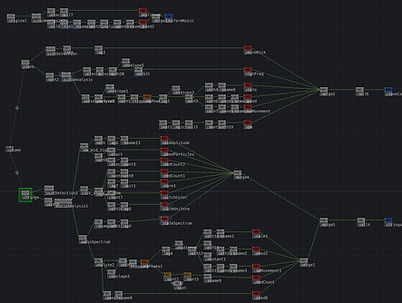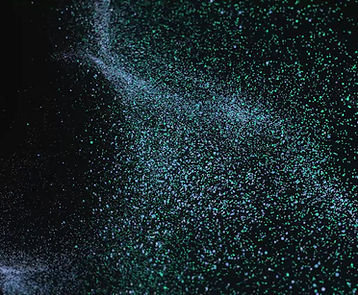
Notturno for Piano Trio: Visualized
This audio-reactive piece was commissioned as the immersive component of the classical concert To Show What Can't Be Said, exhibited at Regent Street's Fyvie Hall in London. It visualizes Schubert’s Notturno for Piano Trio in E-flat major.
More about the event here.
My role - sole designer
Time frame - feb to april 2025
Skills - TouchDesigner, Python, data visualization, immersive design, real-time AV, particle system, generative visuals
Process
This piece was played during the reception. The challenge was to create something that would honor the emotional depth of Schubert’s Notturno, while also blending seamlessly into the social atmosphere without being overly distracting. The resulting approach was a dance between two abstract entities, organically moving across the wall.
I created three distinct visual forms inspired by different audio sources: a dancing white light driven by piano data, a fluid-like form animated by string audio, and a third particle system that echoes both channels together. These forms evolved dynamically throughout the performance, with programmed changes in behavior and intensity at key climactic moments.
Audio Processing
I began by extracting MIDI files for both the piano and string components of the piece. I then analyzed and refined the audio using techniques like beat detection, high-frequency analysis, and rhythm tracking. This approach gave me the flexibility to prototype different visual responses before committing to the final version.


Piano Channel
The piano data animates a white light whose position is driven by amplitude. Its speed is modulated by high-frequency content, creating an erratic, dancing effect that mirrors the instrument’s expressive range.
Strings Channel
The strings control a fluid-like stimulation where both speed and angular momentum respond to the amplitude of the sound. Rotation is driven by mid-frequency data, and the entire system shifts direction whenever a beat is detected, adding a subtle rhythmic sync with the composition.


Uniform Music Particle System
A third particle system remains hidden until climactic moments in the music. When triggered by overall amplitude, it emerges as a unifying visual that bridges the piano and string elements, amplifying the emotional peaks of the piece.
Dynamic Camera Capture
For the performance, I programmed the camera to subtly follow the motion of the piano light, giving a sense of chase and presence.
To further control the viewpoint, I created three sliders that allowed me to adjust the camera’s X, Y, and Z positions in real time, fine-tuning each scene’s framing.
Exhibition
This piece was played during the reception. The challenge was to create something that would honor the emotional depth of Schubert’s Notturno, while also blending seamlessly into the social atmosphere without being overly distracting. The resulting approach was a dance between two abstract entities, organically moving across the wall.


